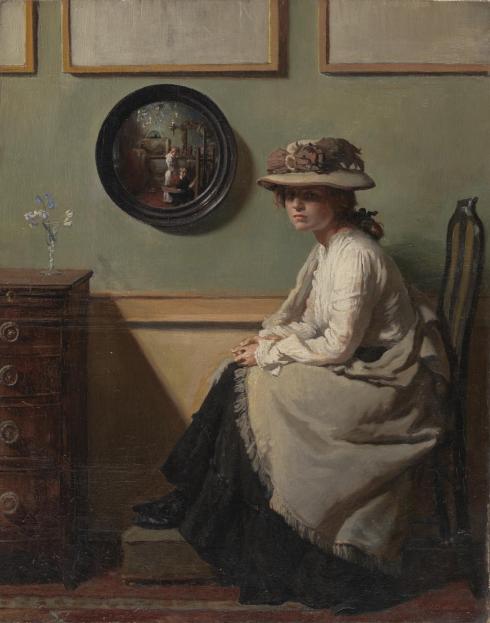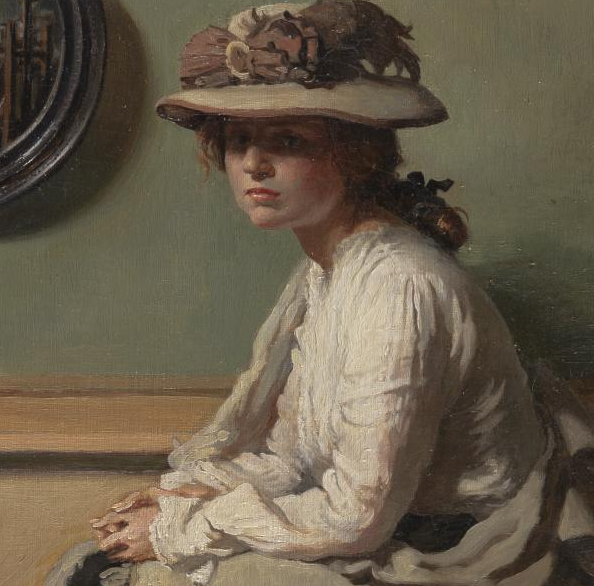 William Orpen, The Mirror, 1900
William Orpen, The Mirror, 1900
This painting keeps haunting me. I don’t quite know why because it’s a really simple portrait, nothing special about it at first sight. I discovered it months ago, and it just lingers in my memory. Every once in a while I remember it and then I gaze it for some time. Then I forget it, and a week passes and then I remember it again and it’s a never ending cycle. The space in the painting isn’t cluttered with many things that tire our eyes. The colours are neutral, greys, black and olive green, nothing overwhelming. The simple arrangement of objects in a painting, with a chest of drawers, a round mirror on the wall and a girl sitting on a chair makes for a simple composition. It also makes it look as if the painter didn’t just capture the space as it was, although it is accurate, but rather chose the objects to make the painting look aesthetically appealing. William Orpen, an Irish painter, was very young when he painted “The Mirror”, just twenty-two years old. He had just recently finished his schooling at the Slate School of Art in London (he studied there from 1897 to 1899), and with this painting he was paying homage to Whistler’s famous “Arrangement in Grey and Black No. 2” or simply A Portrait of the Artist’s Mother painted in 1871. The round mirror on the wall which shows the artist painting is an obvious reference to “The Arnolfini Portrait” painted by Jan van Eyck. But Emily seems to belong to an entirely different world to the one where Orpen is painting. As if the space around her is disappearing and she remains alone on the stage of her life, hiding from us with that hat.

“The Mirror” was painted in Orpen’s lodgings and the model was a girl called Emily Scobel who modeled at the Slade School and was at the time engaged to Orpen, but broke off the engagement the following year and eventually married someone else. She was the main model for Orpen’s early works. With the simple composition and sombre colours, Orpen put a focus on Emily’s face because that’s where the real drama takes place. Her face is very captivating to me and it seems to say so much. Half hidden in the shade of her lovely hat, the same hat you can see in a drawing of Emily that Orpen made in 1901, her eyes are full of doubt and slight disappointment; I feel like she’s come to the point where she doesn’t know what to do with her life and she’s staring into the grey future with worrying eyes that seem to say: and what now? Her shoulders are sloping and her hands are clasped in her laps. She is sitting there in her long black skirt and white blouse, but her thoughts are somewhere else. Cheeks of her round face are pink as roses, but her lips pressed together are hiding secrets that she is hesitant to tell us. When I look at her face, and I have gazed at it for quite some time on different occasions, the lyrics to the Pulp’s song “Monday Morning” comes to mind:
There’s nothing to do so you just stay in bed,
Oh poor thing,
Why live in the world when you can live in your head?
Mmm when you can go out late from Monday,
Till Saturday turns into Sunday,
And now you’re back here at Monday,
So we can do it all over again.
And you go aah ah ah
I want a refund,
I want a light,
I want a reason,
To make it through the night, alright.
And so you finally left school,
So now what are you going to do?
Now you’re so grown up,
Yeah you’re oh oh oh oh oh so mature oh.

William Orpen, A Study – Emily Scobel, 1901, red chalk, graphite and grey wash


